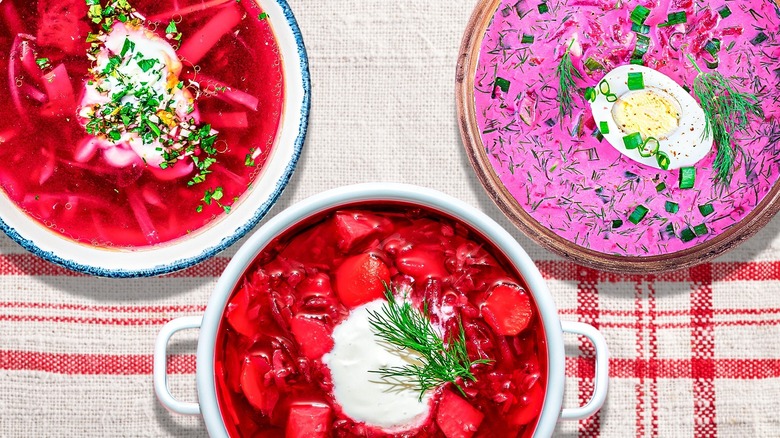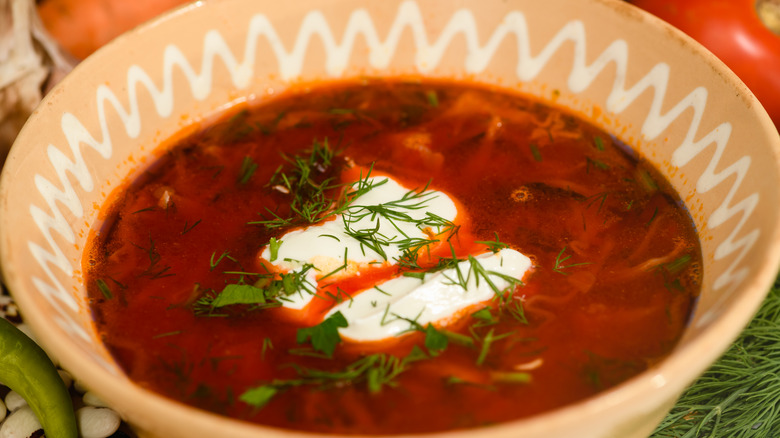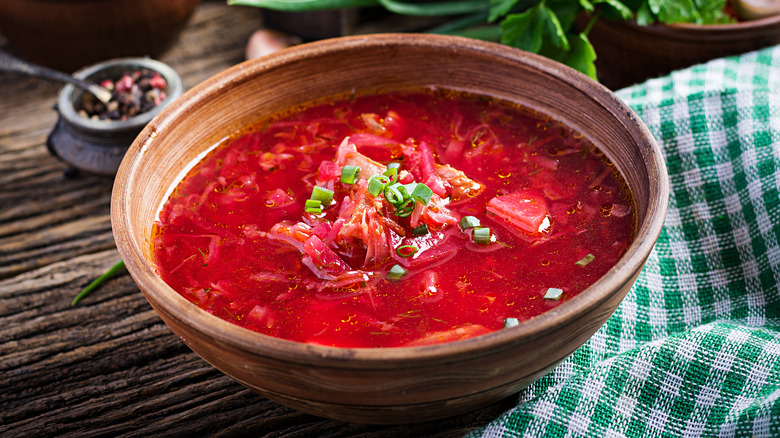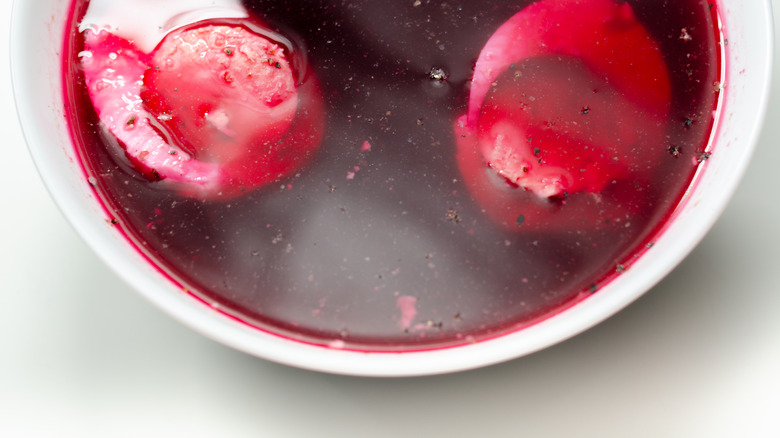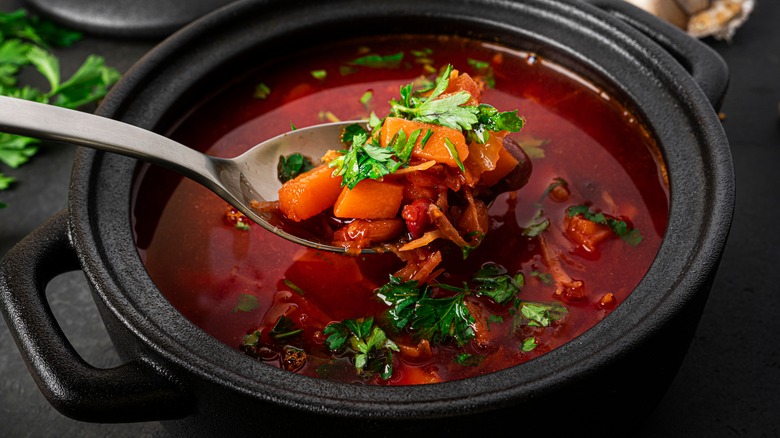What To Know About The Endless Different Varieties Of Borscht
Food's regional nature can be complicated; many dishes evolve across cultural and political boundaries. However, as a source of national pride, enthusiastic cooks seek to claim a rendition as their own. Recently, borscht, the comforting beet soup, has received the limelight as an example of culinary tension. With the Russian invasion, Ukraine assembled documentation of the dish's domestic gravity and it was approved for induction on a UNESCO list of endangered traditions.
And although the food has undeniably deep roots in the Eastern European nation, it's also a popular dish in a multitude of other countries, too. From the Baltics to Poland, Russia, Romania, and even eastward into the Caucasus and Asia, the dish takes on a dizzying variation of forms — estimated to be well over a hundred. Utilizing a malleable base of root vegetables, oftentimes meat, and hearty stock, borscht represents a comforting homemade creation to many people. Let's dive into some of its most notable renditions.
Ukrainian borscht offers a thick version of the soup with sour components
With such an assortment of variations, it's no surprise even Ukrainian borscht takes upon several forms. Most generally, it's divided into three types: the classic bright red variety with beets, a springtime herbal green version, and a cold version reminiscent of chłodnik.
Most renditions of the dish employ classic Ukrainian techniques, such as the use of smazhennia, a sauteed base of chopped carrots, and onions. Plus, it frequently integrates kvashennia, or vegetable ferments, which lend it an acidic character. When it comes to the meat base, slowly simmered oxtail is a popular choice, which lends a rich, meaty character. However, some believe pork ribs are the most traditional meat base.
Ukrainian borscht is thicker than other varieties, and its dense texture integrates a bouquet of delicious ingredients. Common borscht additions like potatoes, cabbage, and beetroot are oftentimes present. Farmers further embellish by incorporating regional, locally sourced produce, too. Whether it's kidney beans, green onions, or eel, the Ukrainian rendition is an emblematic expression of the seasonal nature of the dish.
Russian borscht is typically a more liquidy, heartier stew
Since the largest Slavic nation assimilated a multitude of borscht renditions from neighboring cultures, untangling what is specifically Russian borscht is complicated. The nation's expression is interlinked with the common base of beetroot, cabbage, and potatoes, all stewed into a beef base. However, deviations are abundant, and the composition isn't stringent.
The stock starter is often mixed, whether it's with cured sausage, poultry, or vegetables. Texturally, Russian borscht often leans into thinner consistency, unlike the Ukrainian version. Vegetables, like cabbage, are added at the beginning of preparation, lending a softer result as opposed to the Ukrainian version. Its iconic deep-red color is often accentuated with the addition of tomatoes, although such a technique is more modern.
Lastly, Russian borscht is defined by its carby accompaniment: several slices of black rye bread. These delicious accompaniments — used to sop up the broth — are perhaps the most standard element of the nation's borscht rendition.
Polish barszcz is a soup-like creation with distinct ingredients
In Poland, the dish has a unique name: barszcz. Just like in the other Slavic nations, nearly every cook has their own spin on the dish. Most notably, the Poles craft a delicious chilled version with beetroot and yogurt, which has spun off enough to be known distinctly as chlodnik.
Additionally, the nation prepares a white version, which pairs a pork stock with soured wheat flour — beets are absent from this rendition. Meanwhile, the country's spin on red barszcz often employs fermented beets to amplify the sour notes, like in Ukrainian renditions.
Polish barszcz offers a clearer, vegetarian broth, unlike other meat-heavy neighboring versions. Dried mushrooms are a common addition, which lends it an extra savouryiness. And even when beef is utilized, barszcz's lighter texture is furthered by a straining step. Such a technique pivots the dish to a more soup-like quality. When it comes to the topping, small mushroom or sauerkraut-filled dumplings called uszka are most commonly ladled into the soup.
Renditions of borscht outside Eastern Europe
The ever-shifting stew takes on even more variations outside the Eastern European region. Since the dish was regarded as an iconic Soviet dish, it spread to most areas formerly governed by the U.S.S.R.
In the Caucasus region, for example, the dish integrates regional ingredients like fresh herbs and spicy peppers. And while beef is the most common base in this region, some imbue a local variation by utilizing lamb. Otherwise, this borscht sticks to a faithful vegetable foundation of cabbage, beets, potatoes, and other root vegetables. Perhaps by way of the Armenian diaspora, the soup also spread to Iran, where the dish relies on a similar assembly of ingredients but with local meat cuts.
And intermingling between Russia and China even spread the dish all the way to Hong Kong. Crafted with a few local inflections, such as ginger and ketchup, this rendition — called luo song tang — doesn't utilize beets. Since the vegetable isn't popular in the region, a combination of tomato products is used to replicate the red color. So, needless to say, borscht's expansive array of regional styles is impressive, and determining which one's most emblematic is impossible.
